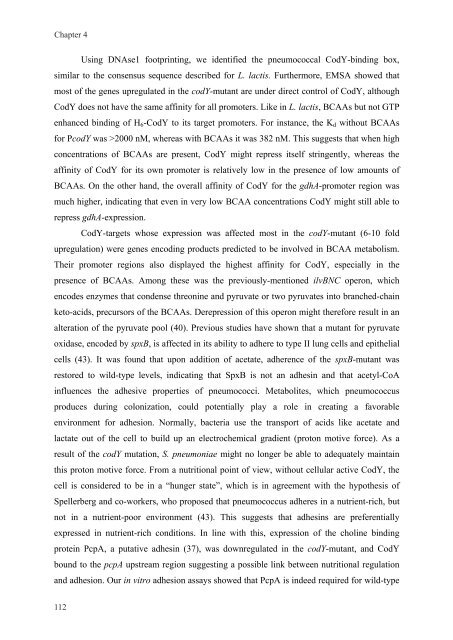Gene regulation in Streptococcus pneumoniae - RePub - Erasmus ...
Gene regulation in Streptococcus pneumoniae - RePub - Erasmus ...
Gene regulation in Streptococcus pneumoniae - RePub - Erasmus ...
You also want an ePaper? Increase the reach of your titles
YUMPU automatically turns print PDFs into web optimized ePapers that Google loves.
Chapter 4<br />
112<br />
112<br />
Us<strong>in</strong>g DNAse1 footpr<strong>in</strong>t<strong>in</strong>g, we identified the pneumococcal CodY-b<strong>in</strong>d<strong>in</strong>g box,<br />
similar to the consensus sequence described for L. lactis. Furthermore, EMSA showed that<br />
most of the genes upregulated <strong>in</strong> the codY-mutant are under direct control of CodY, although<br />
CodY does not have the same aff<strong>in</strong>ity for all promoters. Like <strong>in</strong> L. lactis, BCAAs but not GTP<br />
enhanced b<strong>in</strong>d<strong>in</strong>g of H6-CodY to its target promoters. For <strong>in</strong>stance, the Kd without BCAAs<br />
for PcodY was >2000 nM, whereas with BCAAs it was 382 nM. This suggests that when high<br />
concentrations of BCAAs are present, CodY might repress itself str<strong>in</strong>gently, whereas the<br />
aff<strong>in</strong>ity of CodY for its own promoter is relatively low <strong>in</strong> the presence of low amounts of<br />
BCAAs. On the other hand, the overall aff<strong>in</strong>ity of CodY for the gdhA-promoter region was<br />
much higher, <strong>in</strong>dicat<strong>in</strong>g that even <strong>in</strong> very low BCAA concentrations CodY might still able to<br />
repress gdhA-expression.<br />
CodY-targets whose expression was affected most <strong>in</strong> the codY-mutant (6-10 fold<br />
up<strong>regulation</strong>) were genes encod<strong>in</strong>g products predicted to be <strong>in</strong>volved <strong>in</strong> BCAA metabolism.<br />
Their promoter regions also displayed the highest aff<strong>in</strong>ity for CodY, especially <strong>in</strong> the<br />
presence of BCAAs. Among these was the previously-mentioned ilvBNC operon, which<br />
encodes enzymes that condense threon<strong>in</strong>e and pyruvate or two pyruvates <strong>in</strong>to branched-cha<strong>in</strong><br />
keto-acids, precursors of the BCAAs. Derepression of this operon might therefore result <strong>in</strong> an<br />
alteration of the pyruvate pool (40). Previous studies have shown that a mutant for pyruvate<br />
oxidase, encoded by spxB, is affected <strong>in</strong> its ability to adhere to type II lung cells and epithelial<br />
cells (43). It was found that upon addition of acetate, adherence of the spxB-mutant was<br />
restored to wild-type levels, <strong>in</strong>dicat<strong>in</strong>g that SpxB is not an adhes<strong>in</strong> and that acetyl-CoA<br />
<strong>in</strong>fluences the adhesive properties of pneumococci. Metabolites, which pneumococcus<br />
produces dur<strong>in</strong>g colonization, could potentially play a role <strong>in</strong> creat<strong>in</strong>g a favorable<br />
environment for adhesion. Normally, bacteria use the transport of acids like acetate and<br />
lactate out of the cell to build up an electrochemical gradient (proton motive force). As a<br />
result of the codY mutation, S. <strong>pneumoniae</strong> might no longer be able to adequately ma<strong>in</strong>ta<strong>in</strong><br />
this proton motive force. From a nutritional po<strong>in</strong>t of view, without cellular active CodY, the<br />
cell is considered to be <strong>in</strong> a “hunger state”, which is <strong>in</strong> agreement with the hypothesis of<br />
Spellerberg and co-workers, who proposed that pneumococcus adheres <strong>in</strong> a nutrient-rich, but<br />
not <strong>in</strong> a nutrient-poor environment (43). This suggests that adhes<strong>in</strong>s are preferentially<br />
expressed <strong>in</strong> nutrient-rich conditions. In l<strong>in</strong>e with this, expression of the chol<strong>in</strong>e b<strong>in</strong>d<strong>in</strong>g<br />
prote<strong>in</strong> PcpA, a putative adhes<strong>in</strong> (37), was downregulated <strong>in</strong> the codY-mutant, and CodY<br />
bound to the pcpA upstream region suggest<strong>in</strong>g a possible l<strong>in</strong>k between nutritional <strong>regulation</strong><br />
and adhesion. Our <strong>in</strong> vitro adhesion assays showed that PcpA is <strong>in</strong>deed required for wild-type

















